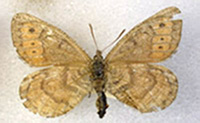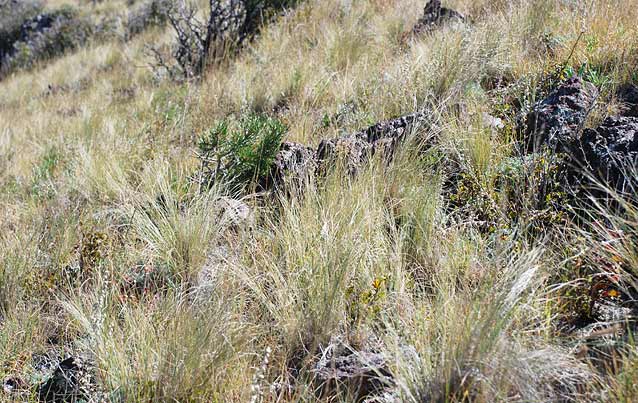North American butterflies belonging to the genus Oeneis are referred to as “arctics” in recognition of the windy, often high-elevation, tundra-like habitats they generally inhabit. The Capulin Alberta arctic butterfly is one such species and was first found by Brown, an entomologist with the American Museum of Natural History, at Capulin Volcano National Monument’s crater rim in 1969.

This butterfly was soon determined to be a new subspecies that is known only to Capulin Volcano NM and some nearby areas on the Raton Mesa complex (Union and Colfax counties, New Mexico), but it is not listed as a state or federally threatened or endangered species.
Status and Trends
The Capulin Alberta arctic butterfly (Oeneis alberta capulinensis) is described as small and as having variable coloration, from light to darker grayish-brown. The butterfly’s underside is lighter than the upper side, and the female may appear brighter in color than the male. The monument’s habitat for the Capulin Alberta arctic butterfly has been identified as Arizona fescue-mountain muhly grassland that is located at the top of the volcano.
Since it was first identified in 1969, it has been observed an additional six times at the monument, with the last observation occurring in 1996. A formal survey was last conducted in 2004 to determine its abundance and distribution. Although none were detected in the monument during the 2004 survey, they were observed at other locations throughout Johnson Mesa, but in lower numbers compared to previous years’ surveys.

Discussion
The Capulin subspecies of the Alberta arctic butterfly faces potential threats in its range. Because of the population’s small size, natural or human impacts could threaten the existence of this subspecies. Additionally, there are several types of uncertainties involving the natural history and biology of the Capulin Alberta arctic butterfly and its occurrence at the monument. The lack of professionally conducted, systematic surveys, along with the species’ natural variability, makes it very difficult to determine presence/absence. Additionally, wind and other climatic factors can affect when and whether the butterflies fly, and therefore affect observability. Even aspects of the butterfly itself may make it difficult to survey. Brown described the Capulin Alberta arctic butterfly as rarely flying “until it is kicked out of the grass clumps.” When the butterfly does fly, its flight is erratic, rapid, and low, often less than a foot above the grass. Additionally, Brown reported only males flying; female butterflies seen on the ground were either crawling among the grass clumps or disappearing into crevices among the cinders. The butterfly also flies in only one generation per year (completes one breeding cycle). Systematic surveys for the Capulin Alberta arctic butterfly, both locally and regionally, may help provide the information that is necessary to assist with the conservation of this rare species.
For More Information
Bennetts, R. E., K. Struthers, P. Valentine-Darby, T. Folts, H. Sosinski, and E. Yost . 2011. Capulin Volcano National Monument: Natural Resource Condition Assessment. Natural Resource Report NPS/SOPN/NRR—2012/492.National Park Service, Fort Collins, Colorado.
Prepared by the Southern Plains Network Inventory and Monitoring Program, 2012.
Last updated: July 24, 2015
